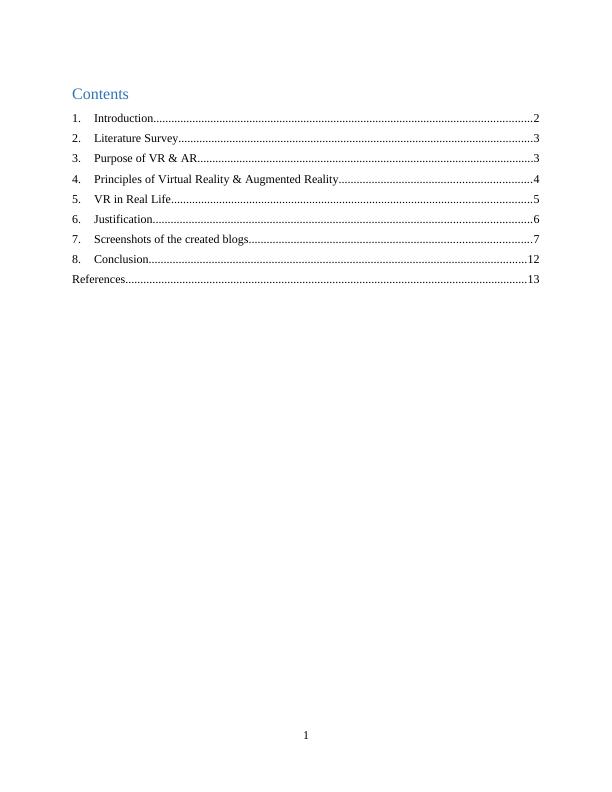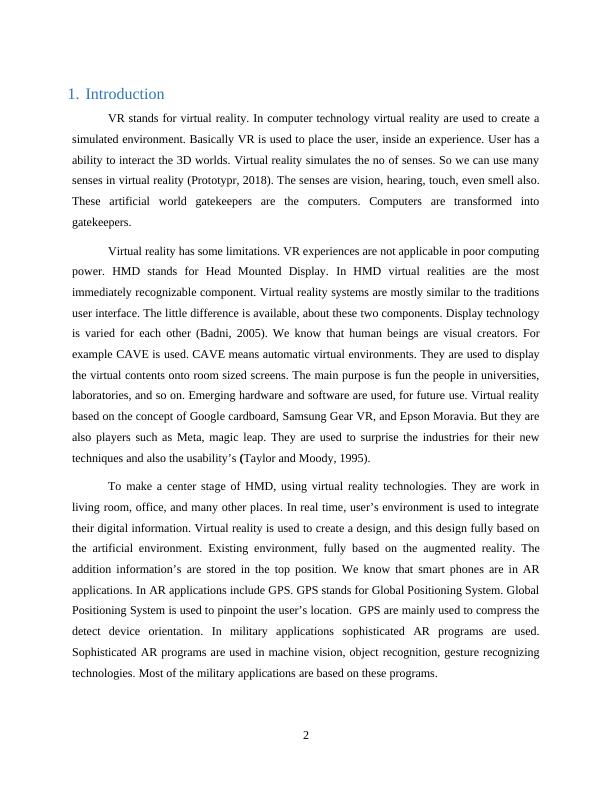Ask a question from expert
Principles of Virtual Reality & Augmented Reality - Doc
15 Pages3073 Words271 Views
Added on 2021-06-18
Principles of Virtual Reality & Augmented Reality - Doc
Added on 2021-06-18
BookmarkShareRelated Documents
Contents1.Introduction..............................................................................................................................22.Literature Survey......................................................................................................................33.Purpose of VR & AR................................................................................................................34.Principles of Virtual Reality & Augmented Reality................................................................45.VR in Real Life........................................................................................................................56.Justification..............................................................................................................................67.Screenshots of the created blogs..............................................................................................78.Conclusion..............................................................................................................................12References......................................................................................................................................131

1.IntroductionVR stands for virtual reality. In computer technology virtual reality are used to create asimulated environment. Basically VR is used to place the user, inside an experience. User has aability to interact the 3D worlds. Virtual reality simulates the no of senses. So we can use manysenses in virtual reality(Prototypr, 2018). The senses are vision, hearing, touch, even smell also.These artificial world gatekeepers are the computers. Computers are transformed intogatekeepers. Virtual reality has some limitations. VR experiences are not applicable in poor computingpower. HMD stands for Head Mounted Display. In HMD virtual realities are the mostimmediately recognizable component. Virtual reality systems are mostly similar to the traditionsuser interface. The little difference is available, about these two components. Display technologyis varied for each other (Badni, 2005). We know that human beings are visual creators. Forexample CAVE is used. CAVE means automatic virtual environments. They are used to displaythe virtual contents onto room sized screens. The main purpose is fun the people in universities,laboratories, and so on. Emerging hardware and software are used, for future use. Virtual realitybased on the concept of Google cardboard, Samsung Gear VR, and Epson Moravia. But they arealso players such as Meta, magic leap. They are used to surprise the industries for their newtechniques and also the usability’s (Taylor and Moody, 1995). To make a center stage of HMD, using virtual reality technologies. They are work inliving room, office, and many other places. In real time, user’s environment is used to integratetheir digital information. Virtual reality is used to create a design, and this design fully based onthe artificial environment. Existing environment, fully based on the augmented reality. Theaddition information’s are stored in the top position. We know that smart phones are in ARapplications. In AR applications include GPS. GPS stands for Global Positioning System. GlobalPositioning System is used to pinpoint the user’s location. GPS are mainly used to compress thedetect device orientation. In military applications sophisticated AR programs are used.Sophisticated AR programs are used in machine vision, object recognition, gesture recognizingtechnologies. Most of the military applications are based on these programs. 2

2.Literature Survey“Morton Heilig” was the pioneer of the VR technologies. In the year of 1957 it wascreated to show the 3-D world to the users. It provides the effects like sound, odor, motions etc.It was known as “Sensorama”.After some years later (1968) a person his name is “Ivan Sutherland” invented the actualmodel of VR system. It was actually need to mount the device with the users head. That wasknown as “The Sword of Damocles”.“The Super Cockpit” was the next notable invention in the VR technologies. During1980s it was in its peak. This system was developed by “Thomas Furness”. That was developedfor the military purpose.In 1978 a new technology was developed by the “MIT & DARPA” which was called as“The Aspen Movie Map”. In 1991 “Sega VR” was invented. It has a LCD & Speakers with some lens setup to givethe 3-D experience to the users. A young man “Palmer Luckey” developed the “Enter Oculus” in the year of 2010. It wasthe most noticeable device in the era. Now the many companies develop their VR devices like “HTC Vive & GoogleCardboard”. Some other companies also carry the research in this field.3.Purpose of VR & ARFirst, the virtual reality is very simple. It is a technology used in the industries. But thistechnology mainly have a contribution in human’s factors in the way of connections and tellingstories. In that story telling photography and film making has the important role to the help ofpeoples (Barfield, 2007). By the way the virtual reality helps to the human. Virtual reality is thefirst evolving technique in that story telling at the stages of film. And it does not have the controlcompletely what the people will see and when and this kind of technique is very interesting(Vr.google.com, 2018). When the person use the headset for the first time they look up rightaway then side and then they can realize. From these specifications it had some significant for3

story tellers. And the techniques also had some drawback. Virtual reality is mainly used foreliminating the ambiguity. Some peoples are not convenient to translating words and imagesinto reality. Virtual reality is used day by day as VR engine for architecture and design. Mostlyclients have the estimation about struggle people in translating 2D into 3 space and so for thatvirtual reality helps to translate (Kreylos, 2018). And it also used for designers for betterunderstand about scale and that explanation is also specified in the virtual reality. Andaugmented reality is most familiar technique in the software development and it has a focusabout Google products. Augmented reality is the technique used in computer vision based onsuch algorithms helps to the real world products in the way of audio, video and graphics. It hadthe interaction with virtual element to develop a product. Augmented reality shows theinformation about the products what the field we need like Google glass. And it had theimportant role in education department. By the usage of augmented reality we can access the realtime information. In the translation of text, audio and video it is very useful and it is used in 3Ddevelopment. In current scenario most of the industries need the augmented reality for the bestsolution. Virtual and augmented reality is the much needed technology in the industries.4.Principles of Virtual Reality & Augmented RealityEach and every technology that must have a set of rules and regulations, without this thatnot function in an ethical manner (Virtual Reality Society, 2018). Here we would see about thevarious principles they are followed while creating the VR & AR technologies(Developer.apple.com, 2018).4

End of preview
Want to access all the pages? Upload your documents or become a member.
Related Documents
Augmented Reality: Introduction, System, Goal, Working, Display, Technologies, Applications, and Conclusionlg...
|16
|796
|374
Augmented Reality and Virtual Realitylg...
|5
|521
|115
Literature Review on Applications for Augmented Realitylg...
|5
|1300
|247
AUGMENTED REALITY AND VIRTUAL REALITY.lg...
|12
|277
|47
Virtual Reality Offers Multiple Useful Applicationslg...
|11
|2506
|26
Virtual Reality for Business Research and Workplace: An Overviewlg...
|9
|2295
|202